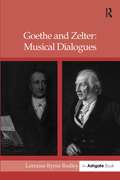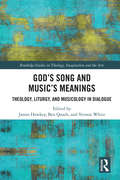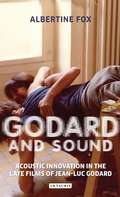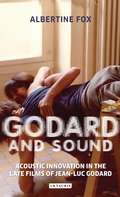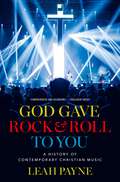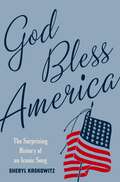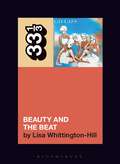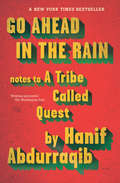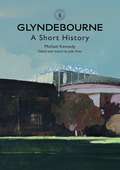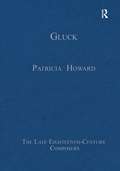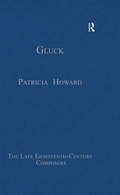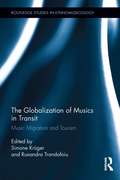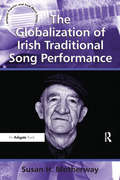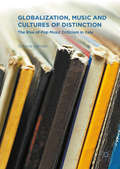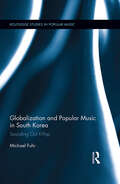- Table View
- List View
Goethe and Zelter: Musical Dialogues
by LorraineByrne BodleyGoethe and Zelter spent a staggering 33 years corresponding or in the case of each artist, over two thirds of their lives. Zelter's position as director of the Sing-Akademie zu Berlin and Goethe's location in Weimar resulted in a wide-ranging correspondence. Goethe's letters offer a chronicle of his musical development, from the time of his journey to Italy to the final months of his life. Zelter's letters retrace his path as stonemason to Professor of Music in Berlin. The 891 letters that passed between these artists provide an important musical record of the music performed in public concerts in Berlin and in the private and semi-public soir of the Weimar court. Their letters are those of men actively engaged in the musical developments of their time. The legacy contains a wide spectrum of letters, casual and thoughtfully composed, spontaneous and written for publication, rich with the details of Goethe's and Zelter's musical lives. Through Zelter, Goethe gained access to the professional music world he craved and became acquainted with the prodigious talent of Felix Mendelssohn. A single letter from Zelter might bear a letter from Felix Mendelssohn to another recipient of the same family, reflecting a certain community in the Mendelssohn household where letters were not considered private but shared with others in a circle of friends or family. Goethe recognized the value of such correspondence: he complains when his friend is slow to send letters in return for those written to him by the poet, a complaint common in this written culture where letters provided news, introductions, literary and musical works. This famous correspondence contains a medley of many issues in literature, art, and science; but the main focus of this translation is the music dialogues of these artists.
Goethe and Zelter: Musical Dialogues
by LorraineByrne BodleyGoethe and Zelter spent a staggering 33 years corresponding or in the case of each artist, over two thirds of their lives. Zelter's position as director of the Sing-Akademie zu Berlin and Goethe's location in Weimar resulted in a wide-ranging correspondence. Goethe's letters offer a chronicle of his musical development, from the time of his journey to Italy to the final months of his life. Zelter's letters retrace his path as stonemason to Professor of Music in Berlin. The 891 letters that passed between these artists provide an important musical record of the music performed in public concerts in Berlin and in the private and semi-public soir of the Weimar court. Their letters are those of men actively engaged in the musical developments of their time. The legacy contains a wide spectrum of letters, casual and thoughtfully composed, spontaneous and written for publication, rich with the details of Goethe's and Zelter's musical lives. Through Zelter, Goethe gained access to the professional music world he craved and became acquainted with the prodigious talent of Felix Mendelssohn. A single letter from Zelter might bear a letter from Felix Mendelssohn to another recipient of the same family, reflecting a certain community in the Mendelssohn household where letters were not considered private but shared with others in a circle of friends or family. Goethe recognized the value of such correspondence: he complains when his friend is slow to send letters in return for those written to him by the poet, a complaint common in this written culture where letters provided news, introductions, literary and musical works. This famous correspondence contains a medley of many issues in literature, art, and science; but the main focus of this translation is the music dialogues of these artists.
God’s Song and Music’s Meanings: Theology, Liturgy, and Musicology in Dialogue (Routledge Studies in Theology, Imagination and the Arts)
by James Hawkey Ben Quash Vernon WhiteTaking seriously the practice and not just the theory of music, this ground-breaking collection of essays establishes a new standard for the interdisciplinary conversation between theology, musicology, and liturgical studies. The public making of music in our society happens more often in the context of chapels, churches, and cathedrals than anywhere else. The command to sing and make music to God makes music an essential part of the DNA of Christian worship. The book’s three main parts address questions about the history, the performative contexts, and the nature of music. Its opening four chapters traces how accounts of music and its relation to God, the cosmos, and the human person have changed dramatically through Western history, from the patristic period through medieval, Reformation and modern times. A second section examines the role of music in worship, and asks what—if anything—makes a piece of music suitable for religious use. The final part of the book shows how the serious discussion of music opens onto considerations of time, tradition, ontology, anthropology, providence, and the nature of God. A pioneering set of explorations by a distinguished group of international scholars, this book will be of interest to anyone interested in Christianity’s long relationship with music, including those working in the fields of theology, musicology, and liturgical studies.
God’s Song and Music’s Meanings: Theology, Liturgy, and Musicology in Dialogue (Routledge Studies in Theology, Imagination and the Arts)
by James Hawkey Ben Quash Vernon WhiteTaking seriously the practice and not just the theory of music, this ground-breaking collection of essays establishes a new standard for the interdisciplinary conversation between theology, musicology, and liturgical studies. The public making of music in our society happens more often in the context of chapels, churches, and cathedrals than anywhere else. The command to sing and make music to God makes music an essential part of the DNA of Christian worship. The book’s three main parts address questions about the history, the performative contexts, and the nature of music. Its opening four chapters traces how accounts of music and its relation to God, the cosmos, and the human person have changed dramatically through Western history, from the patristic period through medieval, Reformation and modern times. A second section examines the role of music in worship, and asks what—if anything—makes a piece of music suitable for religious use. The final part of the book shows how the serious discussion of music opens onto considerations of time, tradition, ontology, anthropology, providence, and the nature of God. A pioneering set of explorations by a distinguished group of international scholars, this book will be of interest to anyone interested in Christianity’s long relationship with music, including those working in the fields of theology, musicology, and liturgical studies.
Godard and Sound: Acoustic Innovation in the Late Films of Jean-Luc Godard
by Albertine FoxWhat happens when we listen to a film? How can we describe the relationship of sound to vision in cinema, and in turn our relationship as spectators with the audio-visual? Jean-Luc Godard understood the importance of the soundtrack in cinema and relied heavily on the impact of carefully constructed sound to produce innovative effects. For the first time, this book brings together his post-1979 multimedia works, and an analysis of their rich soundscapes.The book provides detailed critical discussions of feature-length films, shorts and videos, delving into Godard's inventive experiments with the cinematic soundtrack and offering new insights into his latest 3D films. By detailing the production contexts and philosophy behind Godard's idiosyncratic sound design, it provides an accessible route to understanding his complex use of music, speech and environmental sound, alongside the distorting effects of speed alteration and auditory excess. The book is framed by the concept of 'acoustic spectatorship': a way of cultivating active listening in the viewer.It also draws on ideas by leading sound theorists, philosophers, musicians, and poets, giving particular emphasis to the pioneering thought of French sound engineer and theorist, Pierre Schaeffer.Softening the boundaries between film studies, sound studies and musicology, Godard and Sound re-evaluates Godard's work from a sonic perspective, and will prove essential reading for those wishing to rebalance the importance of sound for the study of cinema.
Godard and Sound: Acoustic Innovation in the Late Films of Jean-Luc Godard (International Library of the Moving Image (PDF))
by Albertine FoxWhat happens when we listen to a film? How can we describe the relationship of sound to vision in cinema, and in turn our relationship as spectators with the audio-visual? Jean-Luc Godard understood the importance of the soundtrack in cinema and relied heavily on the impact of carefully constructed sound to produce innovative effects. For the first time, this book brings together his post-1979 multimedia works, and an analysis of their rich soundscapes.The book provides detailed critical discussions of feature-length films, shorts and videos, delving into Godard's inventive experiments with the cinematic soundtrack and offering new insights into his latest 3D films. By detailing the production contexts and philosophy behind Godard's idiosyncratic sound design, it provides an accessible route to understanding his complex use of music, speech and environmental sound, alongside the distorting effects of speed alteration and auditory excess. The book is framed by the concept of 'acoustic spectatorship': a way of cultivating active listening in the viewer. It also draws on ideas by leading sound theorists, philosophers, musicians, and poets, giving particular emphasis to the pioneering thought of French sound engineer and theorist, Pierre Schaeffer. Softening the boundaries between film studies, sound studies and musicology, Godard and Sound re-evaluates Godard's work from a sonic perspective, and will prove essential reading for those wishing to rebalance the importance of sound for the study of cinema.
God Gave Rock and Roll to You: A History of Contemporary Christian Music
by Leah PayneAn entertaining history of the soundtrack of American evangelical Christianity Few things frightened conservative white Protestant parents of the 1950s and the 1960s more than thought of their children falling prey to the "menace to Christendom" known as rock and roll. The raucous sounds of Elvis Presley and Little Richard seemed tailor-made to destroy the faith of their young and, in the process, undermine the moral foundations of the United States. Parents and pastors launched a crusade against rock music, but they were fighting an uphill battle. Salvation came in a most unlikely form. Well, maybe not that unlikely--the long hair, the beards, the sandals--but still a far cry from the buttoned-up, conservative Protestantism they were striving to preserve. Yet when a revival swept through counterculture hippie communities of the West Coast in the 1960s and 1970s a new alternative emerged. Known as the Jesus Movement--and its members, more colloquially, as "Jesus freaks"--the revival was short-lived. But by combining the rock and folk music of the counterculture with religious ideas and aims of conservative white evangelicals, Jesus freaks and evangelical media moguls gave birth to an entire genre known as Contemporary Christian Music (CCM). By the 1980s and 1990s, CCM had grown into a massive, multimillion-dollar industry. Contemporary Christian artists were appearing on Top 40 radio, and some, most famously Amy Grant, crossed over into the mainstream. And yet, today, the industry is a shadow of what it once was. In this book, Leah Payne traces the history and trajectory of CCM in America and, in the process, demonstrates how the industry, its artists, and its fans shaped--and continue to shape--conservative, (mostly) white, evangelical Protestantism. For many outside observers, evangelical pop stars, interpretive dancers, puppeteers, mimes, and bodybuilders are silly expressions of kitsch. Yet Payne argues that these cultural products were sources of power, meaning, and political activism. Throughout, she draws on in-depth interviews with CCM journalists, publishers, producers, and artists, as well as archives, sales and marketing data, fan magazines, merchandise--everything that went into making CCM a thriving subculture. Ultimately, Payne argues, CCM spurred evangelical activism in more potent and lasting ways than any particular doctrine, denomination, culture war, or legislative agenda had before.
God Gave Rock and Roll to You: A History of Contemporary Christian Music
by Leah PayneAn entertaining history of the soundtrack of American evangelical Christianity Few things frightened conservative white Protestant parents of the 1950s and the 1960s more than thought of their children falling prey to the "menace to Christendom" known as rock and roll. The raucous sounds of Elvis Presley and Little Richard seemed tailor-made to destroy the faith of their young and, in the process, undermine the moral foundations of the United States. Parents and pastors launched a crusade against rock music, but they were fighting an uphill battle. Salvation came in a most unlikely form. Well, maybe not that unlikely--the long hair, the beards, the sandals--but still a far cry from the buttoned-up, conservative Protestantism they were striving to preserve. Yet when a revival swept through counterculture hippie communities of the West Coast in the 1960s and 1970s a new alternative emerged. Known as the Jesus Movement--and its members, more colloquially, as "Jesus freaks"--the revival was short-lived. But by combining the rock and folk music of the counterculture with religious ideas and aims of conservative white evangelicals, Jesus freaks and evangelical media moguls gave birth to an entire genre known as Contemporary Christian Music (CCM). By the 1980s and 1990s, CCM had grown into a massive, multimillion-dollar industry. Contemporary Christian artists were appearing on Top 40 radio, and some, most famously Amy Grant, crossed over into the mainstream. And yet, today, the industry is a shadow of what it once was. In this book, Leah Payne traces the history and trajectory of CCM in America and, in the process, demonstrates how the industry, its artists, and its fans shaped--and continue to shape--conservative, (mostly) white, evangelical Protestantism. For many outside observers, evangelical pop stars, interpretive dancers, puppeteers, mimes, and bodybuilders are silly expressions of kitsch. Yet Payne argues that these cultural products were sources of power, meaning, and political activism. Throughout, she draws on in-depth interviews with CCM journalists, publishers, producers, and artists, as well as archives, sales and marketing data, fan magazines, merchandise--everything that went into making CCM a thriving subculture. Ultimately, Payne argues, CCM spurred evangelical activism in more potent and lasting ways than any particular doctrine, denomination, culture war, or legislative agenda had before.
God Bless America: The Surprising History of an Iconic Song
by Sheryl Kaskowitz"God Bless America" is a song most Americans know well. It is taught in American schools and regularly performed at sporting events. After the attacks on September 11th, it was sung on the steps of the Capitol, at spontaneous memorial sites, and during the seventh inning stretch at baseball games, becoming even more deeply embedded in America's collective consciousness. In God Bless America, Sheryl Kaskowitz tells the fascinating story behind America's other national anthem. It begins with the song's composition by Irving Berlin in 1918 and first performance by Kate Smith in 1938, revealing an early struggle for control between composer and performer as well as the hidden economics behind the song's royalties. Kaskowitz shows how the early popularity of "God Bless America" reflected the anxiety of the pre-war period and sparked a surprising anti-Semitic and xenophobic backlash. She follows the song's rightward ideological trajectory from early associations with religious and ethnic tolerance to increasing uses as an anthem for the Christian Right, and considers the song's popularity directly after the September 11th attacks. The book concludes with a portrait of the song's post-9/11 function within professional baseball, illuminating the power of the song - and of communal singing itself - as a vehicle for both commemoration and coercion. A companion website offers streaming audio of recordings referenced in the book, links to videos of relevant performances, appendices of information, and an opportunity for readers to participate in the author's survey. Based on extensive archival research and fieldwork, God Bless America sheds new light on cultural tensions within the U.S., past and present, and offers a historical chronicle that is full of surprises and that will both edify and delight readers from all walks of life.
God Bless America: The Surprising History of an Iconic Song
by Sheryl Kaskowitz"God Bless America" is a song most Americans know well. It is taught in American schools and regularly performed at sporting events. After the attacks on September 11th, it was sung on the steps of the Capitol, at spontaneous memorial sites, and during the seventh inning stretch at baseball games, becoming even more deeply embedded in America's collective consciousness. In God Bless America, Sheryl Kaskowitz tells the fascinating story behind America's other national anthem. It begins with the song's composition by Irving Berlin in 1918 and first performance by Kate Smith in 1938, revealing an early struggle for control between composer and performer as well as the hidden economics behind the song's royalties. Kaskowitz shows how the early popularity of "God Bless America" reflected the anxiety of the pre-war period and sparked a surprising anti-Semitic and xenophobic backlash. She follows the song's rightward ideological trajectory from early associations with religious and ethnic tolerance to increasing uses as an anthem for the Christian Right, and considers the song's popularity directly after the September 11th attacks. The book concludes with a portrait of the song's post-9/11 function within professional baseball, illuminating the power of the song - and of communal singing itself - as a vehicle for both commemoration and coercion. A companion website offers streaming audio of recordings referenced in the book, links to videos of relevant performances, appendices of information, and an opportunity for readers to participate in the author's survey. Based on extensive archival research and fieldwork, God Bless America sheds new light on cultural tensions within the U.S., past and present, and offers a historical chronicle that is full of surprises and that will both edify and delight readers from all walks of life.
The Go-Go's Beauty and the Beat (33 1/3)
by Lisa Whittington-HillThe Go-Go's debut album Beauty and the Beat was released on July 8, 1981. The album spent six weeks in the number one spot on the Billboard charts, produced two hit singles and sold more than two million copies making it one of the most successful debut albums of all time. Beauty and the Beat made the Go-Go's the first, and to date only, female band to have a number one album who not only wrote their own songs, but also played their own instruments.Beauty and the Beat is a ground-breaking album, but the Go-Go's are often overlooked when we talk about influential female musicians. The Go-Go's were a feminist band and Beauty and the Beat a call to arms that inspired generations of women. The band embraced the DIY spirit of Riot Grrrl before there was a Bikini Kill or a Bratmobile. Girls making music on their own terms didn't start with Courtney Love or Beyoncé or Billie Eilish, it started with the Go-Go's. It started with Beauty and the Beat.While they may have controlled their music, the Go-Go's couldn't control the misogyny of the music industry, media and fans. The sexist and tired stereotypes the Go-Go's experienced 40 years ago still exist today. The legacy of Beauty and the Beat is both a celebration of how the record inspired countless girls to make art and music on their own terms, but also a painful reminder of how little has changed in how female musicians are marketed, manipulated, and discarded.
The Go-Go's Beauty and the Beat (33 1/3)
by Lisa Whittington-HillThe Go-Go's debut album Beauty and the Beat was released on July 8, 1981. The album spent six weeks in the number one spot on the Billboard charts, produced two hit singles and sold more than two million copies making it one of the most successful debut albums of all time. Beauty and the Beat made the Go-Go's the first, and to date only, female band to have a number one album who not only wrote their own songs, but also played their own instruments.Beauty and the Beat is a ground-breaking album, but the Go-Go's are often overlooked when we talk about influential female musicians. The Go-Go's were a feminist band and Beauty and the Beat a call to arms that inspired generations of women. The band embraced the DIY spirit of Riot Grrrl before there was a Bikini Kill or a Bratmobile. Girls making music on their own terms didn't start with Courtney Love or Beyoncé or Billie Eilish, it started with the Go-Go's. It started with Beauty and the Beat.While they may have controlled their music, the Go-Go's couldn't control the misogyny of the music industry, media and fans. The sexist and tired stereotypes the Go-Go's experienced 40 years ago still exist today. The legacy of Beauty and the Beat is both a celebration of how the record inspired countless girls to make art and music on their own terms, but also a painful reminder of how little has changed in how female musicians are marketed, manipulated, and discarded.
Go Ahead in the Rain: Notes to A Tribe Called Quest
by Hanif AbdurraqibA stunning homage to A Tribe Called Quest and a musical era that shaped American culture, from critically acclaimed Hanif Abdurraqib.How does one pay homage to A Tribe Called Quest? Hanif Abdurraqib digs into the group’s history and draws from his own experience to reflect on how the band’s distinctive sound resonated among fans like himself.Abdurraqib traces the Tribe’s creative career: from their early days as part of the Afrocentric rap collective known as the Native Tongues, through their first three classic albums, to their eventual breakup and long hiatus. Their work is placed in the context of the broader rap landscape of the 1990s, one upended by sampling laws that forced a reinvention in production methods, the East Coast–West Coast rivalry that threatened to destroy the genre, and some record labels’ shift from focusing on groups to individual MCs.Throughout the narrative Abdurraqib connects both the music and cultural history to their street-level impact and seeks the deeper truths of A Tribe Called Quest; truths that—like the low end, the bass—are not simply heard in the head, but felt in the chest.
Glyndebourne
by Michael Kennedy Julia AriesThis custom-produced edition tells the story of Glyndebourne. Begun by John Christie in 1934, the Glyndebourne Festival saw professional performances of opera in a purpose-built opera house adjoining the historic house on the site, near Lewes in East Sussex. The Festival quickly became a magnet for music lovers across the south of England and beyond. This concise history of Glyndebourne tells the fascinating story of the opera house on the Downs, from the inauguration of the festival under the direction of three exiles from Nazi Germany, through the great post-war years to the grand reconstruction of the opera house in the 1990s, and beyond. With illustrations from Glyndebourne's archive, this is an affectionate portrait of one of the treasures of music in Britain.
Glyndebourne: A Short History (Shire Ser.)
by Michael Kennedy Julia AriesThis custom-produced edition tells the story of Glyndebourne. Begun by John Christie in 1934, the Glyndebourne Festival saw professional performances of opera in a purpose-built opera house adjoining the historic house on the site, near Lewes in East Sussex. The Festival quickly became a magnet for music lovers across the south of England and beyond. This concise history of Glyndebourne tells the fascinating story of the opera house on the Downs, from the inauguration of the festival under the direction of three exiles from Nazi Germany, through the great post-war years to the grand reconstruction of the opera house in the 1990s, and beyond. With illustrations from Glyndebourne's archive, this is an affectionate portrait of one of the treasures of music in Britain.
Gluck (The\late Eighteenth-century Composers Ser. (PDF))
by Patricia HowardThis volume presents a collection of essays by leading Gluck scholars which highlight the best of recent and classic contributions to Gluck scholarship, many of which are now difficult to access. Tracing Gluck’s life, career and legacy, the essays offer a variety of approaches to the major issues and controversies surrounding the composer and his works and range from the degree to which reform elements are apparent in his early operas to his contribution to changing perceptions of Hellenism. The introduction identifies the major topics investigated and highlights the innovatory nature of many of the approaches, particularly those which address perceptions of the composer in the nineteenth and twentieth centuries. This volume, which focuses on one of the most fascinating and influential composers of his era, provides an indispensable resource for academics, scholars and libraries.
Gluck (The\late Eighteenth-century Composers Ser. (PDF))
by Patricia HowardThis volume presents a collection of essays by leading Gluck scholars which highlight the best of recent and classic contributions to Gluck scholarship, many of which are now difficult to access. Tracing Gluck’s life, career and legacy, the essays offer a variety of approaches to the major issues and controversies surrounding the composer and his works and range from the degree to which reform elements are apparent in his early operas to his contribution to changing perceptions of Hellenism. The introduction identifies the major topics investigated and highlights the innovatory nature of many of the approaches, particularly those which address perceptions of the composer in the nineteenth and twentieth centuries. This volume, which focuses on one of the most fascinating and influential composers of his era, provides an indispensable resource for academics, scholars and libraries.
Gluck
by Patricia HowardThis volume presents a collection of essays by leading Gluck scholars which highlight the best of recent and classic contributions to Gluck scholarship, many of which are now difficult to access. Tracing Gluck‘s life, career and legacy, the essays offer a variety of approaches to the major issues and controversies surrounding the composer and his works and range from the degree to which reform elements are apparent in his early operas to his contribution to changing perceptions of Hellenism. The introduction identifies the major topics investigated and highlights the innovatory nature of many of the approaches, particularly those which address perceptions of the composer in the nineteenth and twentieth centuries. This volume, which focuses on one of the most fascinating and influential composers of his era, provides an indispensable resource for academics, scholars and libraries.
Gluck: An Eighteenth-century Portrait In Letters And Documents (The\late Eighteenth-century Composers Ser.)
by Patricia HowardThis volume presents a collection of essays by leading Gluck scholars which highlight the best of recent and classic contributions to Gluck scholarship, many of which are now difficult to access. Tracing Gluck‘s life, career and legacy, the essays offer a variety of approaches to the major issues and controversies surrounding the composer and his works and range from the degree to which reform elements are apparent in his early operas to his contribution to changing perceptions of Hellenism. The introduction identifies the major topics investigated and highlights the innovatory nature of many of the approaches, particularly those which address perceptions of the composer in the nineteenth and twentieth centuries. This volume, which focuses on one of the most fascinating and influential composers of his era, provides an indispensable resource for academics, scholars and libraries.
The Globalization of Musics in Transit: Music Migration and Tourism (Routledge Studies in Ethnomusicology #4)
by Simone Krüger Ruxandra TrandafoiuThis book traces the particularities of music migration and tourism in different global settings, and provides current, even new perspectives for ethnomusicological research on globalizing musics in transit. The dual focus on tourism and migration is central to debates on globalization, and their examination—separately or combined—offers a useful lens on many key questions about where globalization is taking us: questions about identity and heritage, commoditization, historical and cultural representation, hybridity, authenticity and ownership, neoliberalism, inequality, diasporization, the relocation of allegiances, and more. Moreover, for the first time, these two key phenomena—tourism and migration—are studied conjointly, as well as interdisciplinary, in order to derive both parallels and contrasts. While taking diverse perspectives in embracing the contemporary musical landscape, the collection offers a range of research methods and theoretical approaches from ethnomusicology, anthropology, cultural geography, sociology, popular music studies, and media and communication. In so doing, Musics in Transit provides a rich exemplification of the ways that all forms of musical culture are becoming transnational under post-global conditions, sustained by both global markets and musics in transit, and to which both tourists and diasporic cosmopolitans make an important contribution.
The Globalization of Musics in Transit: Music Migration and Tourism (Routledge Studies in Ethnomusicology)
by Ruxandra Trandafoiu Simone KrügerThis book traces the particularities of music migration and tourism in different global settings, and provides current, even new perspectives for ethnomusicological research on globalizing musics in transit. The dual focus on tourism and migration is central to debates on globalization, and their examination—separately or combined—offers a useful lens on many key questions about where globalization is taking us: questions about identity and heritage, commoditization, historical and cultural representation, hybridity, authenticity and ownership, neoliberalism, inequality, diasporization, the relocation of allegiances, and more. Moreover, for the first time, these two key phenomena—tourism and migration—are studied conjointly, as well as interdisciplinary, in order to derive both parallels and contrasts. While taking diverse perspectives in embracing the contemporary musical landscape, the collection offers a range of research methods and theoretical approaches from ethnomusicology, anthropology, cultural geography, sociology, popular music studies, and media and communication. In so doing, Musics in Transit provides a rich exemplification of the ways that all forms of musical culture are becoming transnational under post-global conditions, sustained by both global markets and musics in transit, and to which both tourists and diasporic cosmopolitans make an important contribution.
The Globalization of Irish Traditional Song Performance (Ashgate Popular and Folk Music Series)
by Susan H. MotherwayIn The Globalization of Irish Traditional Song Performance Susan Motherway examines the ways in which performers mediate the divide between local and global markets by negotiating this dichotomy in performance practice. In so doing, she discusses the globalizing processes that exert transformative influences upon traditional musics and examines the response to these influences by Irish traditional song performers. In developing this thesis the book provides an overview of the genre and its subgenres, illustrates patterns of musical change extant within the tradition as a result of globalization, and acknowledges music as a medium for re-negotiating an Irish cultural identity within the global. Given Ireland’s long history of emigration and colonisation, globalization is recognised as both a synchronic and a diachronic phenomenon. Motherway thus examines Anglo-Irish song and songs of the Irish Diaspora. Her analysis reaches beyond essentialist definitions of the tradition to examine evolving sub-genres such as Country & Irish, Celtic and World Music. She also recognizes the singing traditions of other ethnic groups on the island of Ireland including Orange-Order, Ulster-Scots and Traveller song. In so doing, she shows the disparity between native conceptions and native realities in respect to Irish cultural Identity.
The Globalization of Irish Traditional Song Performance (Ashgate Popular and Folk Music Series)
by Susan H. MotherwayIn The Globalization of Irish Traditional Song Performance Susan Motherway examines the ways in which performers mediate the divide between local and global markets by negotiating this dichotomy in performance practice. In so doing, she discusses the globalizing processes that exert transformative influences upon traditional musics and examines the response to these influences by Irish traditional song performers. In developing this thesis the book provides an overview of the genre and its subgenres, illustrates patterns of musical change extant within the tradition as a result of globalization, and acknowledges music as a medium for re-negotiating an Irish cultural identity within the global. Given Ireland’s long history of emigration and colonisation, globalization is recognised as both a synchronic and a diachronic phenomenon. Motherway thus examines Anglo-Irish song and songs of the Irish Diaspora. Her analysis reaches beyond essentialist definitions of the tradition to examine evolving sub-genres such as Country & Irish, Celtic and World Music. She also recognizes the singing traditions of other ethnic groups on the island of Ireland including Orange-Order, Ulster-Scots and Traveller song. In so doing, she shows the disparity between native conceptions and native realities in respect to Irish cultural Identity.
Globalization, Music and Cultures of Distinction: The Rise of Pop Music Criticism in Italy
by Simone VarrialeThis book is the first comprehensive account of how Anglo-American popular music transformed Italian cultural life. Drawing on neglected archival materials, the author explores the rise of new musical tastes and social divisions in late twentieth century Italy. The book reconstructs the emergence of pop music magazines in Italy and offers the first in-depth investigation of the role of critics in global music cultures. It explores how class, gender, race and geographical location shaped the production and consumption of music magazines, as well as critics’ struggle over notions of expertise, cultural value and cosmopolitanism. Globalization, Music and Cultures of Distinction provides an innovative framework for studying how globalization transforms cultural institutions and aesthetic hierarchies, thus breaking new ground for sociological and historical research. It will be essential reading for scholars and students interested in cultural sociology, popular music, globalization, media and cultural studies, social theory and contemporary Italy.
Globalization and Popular Music in South Korea: Sounding Out K-Pop (Routledge Studies in Popular Music)
by Michael FuhrThis book offers an in-depth study of the globalization of contemporary South Korean idol pop music, or K-Pop, visiting K-Pop and its multiple intersections with political, economic, and cultural formations and transformations. It provides detailed insights into the transformative process in and around the field of Korean pop music since the 1990s, which paved the way for the recent international rise of K-Pop and the Korean Wave. Fuhr examines the conditions and effects of transnational flows, asymmetrical power relations, and the role of the imaginary "other" in K-Pop production and consumption, relating them to the specific aesthetic dimensions and material conditions of K-Pop stars, songs, and videos. Further, the book reveals how K-Pop is deployed for strategies of national identity construction in connection with Korean cultural politics, with transnational music production circuits, and with the transnational mobility of immigrant pop idols. The volume argues that K-Pop is a highly productive cultural arena in which South Korea’s globalizing and nationalizing forces and imaginations coincide, intermingle, and counteract with each other and in which the tension between both of these poles is played out musically, visually, and discursively. This book examines a vibrant example of contemporary popular music from the non-Anglophone world and provides deeper insight into the structure of popular music and the dynamics of cultural globalization through a combined set of ethnographic, musicological, and cultural analysis. Widening the regional scope of Western-dominated popular music studies and enhancing new areas of ethnomusicology, anthropology, and cultural studies, this book will also be of interest to those studying East Asian popular culture, music globalization, and popular music.
